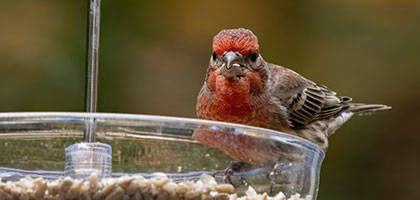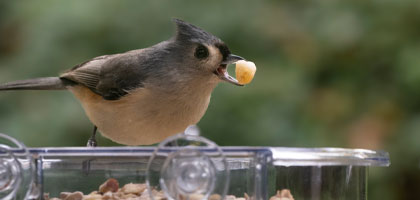Cardinals are a delight to observe. Their vibrant colors and melodious songs make them a favorite among bird enthusiasts.
But what do these beautiful creatures eat?
Understanding their dietary habits is key to attracting them to your yard. It's also essential for their survival, especially during harsh seasons.
In this guide, we'll explore the seasonal feeding habits of cardinals. We'll delve into their preferred foods, from seeds and mixes to fresh fruit and mealworms.
We'll also share cardinal feeding tips and recommend suitable bird feeders. Whether you're a seasoned bird watcher or a beginner, this guide will help you feed and attract cardinals effectively.
Let's embark on this fascinating journey into the world of cardinals.
Understanding Cardinals' Dietary Needs
Cardinals, found throughout the Americas, are non-migratory birds with diverse dietary preferences. Their feeding habits change with the seasons to maximize nutrition and energy intake. This adaptability helps them thrive in various environments and climates.
These birds favor a variety of foods, ensuring their nutritional needs are met. They have a preference for seeds and nuts, with sunflower hearts being a particular favorite. Their strong beaks easily crack open tough seeds, making these foods ideal for them.
In addition to seeds, cardinals also enjoy insects and fresh fruit, which provide essential nutrients. These foods become critical during breeding and colder months when energy demands rise. Understanding these preferences is crucial for attracting and feeding cardinals effectively in your yard.
Spring: Breeding Season and Dietary Shifts
In spring, cardinals shift their diet to prepare for the breeding season. This period demands high energy and nutrition for raising young. Cardinals increase their consumption of protein-rich insects and fresh fruit.
With warming temperatures, insects become abundant, making them an easy food source. The diverse range of bugs helps supply the necessary protein and energy. This intake supports both parent birds and their growing chicks.
Alongside insects, cardinals seek out fresh fruits as an additional energy source. These fruits provide essential vitamins and hydration. Consider offering the following foods to cater to their spring dietary needs:
- Insects like mealworms
- Chopped apples and berries
- Sunflower hearts and other seeds
Summer: Abundance of Insects and Seeds
During the summer months, food is plentiful for cardinals. Warm weather means insects, seeds, and berries are in abundance. This dietary variety keeps cardinals active and healthy.
Cardinals relish the wealth of insects available in the summer. Protein from insects aids in maintaining their energy levels. Feeding cardinals mealworms or larvae can be particularly beneficial.
As the season progresses, cardinals incorporate more seeds and berries into their diet. These foods offer a rich source of carbohydrates and nutrients. To meet their dietary preferences, you might want to provide:
- Seeds and mixes like safflower and sunflower
- Fresh berries and fruit
- Nuts and unsalted peanuts
Fall: Transitioning to Seeds and Grains
As fall arrives, the diet of cardinals begins to shift. Insects become less available, prompting a reliance on seeds and grains. This transition is crucial for preparing cardinals for the colder months ahead.
Cardinals focus on energy-rich foods during the fall. Seeds offer a reliable food source when other options dwindle. Providing a mix of seeds can help meet their nutritional needs.
In the fall, cardinals appreciate a variety of grains and seeds. Consider offering:
- Black oil sunflower seeds
- Safflower seeds
- Cracked corn and milo
Ensuring a plentiful supply of these foods will help cardinals thrive during this season.
Winter: Surviving on Seeds and Suet
Winter presents a challenge for cardinals as natural food sources dwindle. To survive, they rely heavily on seeds and suet. These provide essential nutrients and energy required during the colder months.
In winter, cardinals need high-fat foods to maintain their energy levels. Suet is ideal, offering not only fat but also protein. Supplementing their diet with seeds enhances their nutrition further.
Consider providing the following foods in winter:
- Sunflower seeds
- Suet cakes, pellets, or balls
- Peanuts and nut pieces (unsalted)
These options help cardinals endure winter's harsh conditions. Keeping feeders stocked ensures they have consistent access to these critical resources.
Cardinal Feeding Tips: Best Practices
Feeding cardinals requires understanding their preferences and needs. They enjoy a variety of foods, primarily seeds, nuts, and fruit. Offering a mix caters to their dietary needs throughout the year.
Ensure feeders are clean and placed strategically. Cardinals prefer feeders near shrubs or trees for quick cover. This also reduces exposure to potential predators.
To enhance your feeding setup, consider these tips:
- Use squirrel-proof feeders to protect food supply.
- Provide a steady water source for drinking and bathing.
- Keep feeders filled especially in adverse weather conditions.
- Avoid processed foods like bread, offering little nutritional value.
Adopting these best practices creates a welcoming environment for cardinals. This not only attracts them but also helps maintain their health and well-being.
Choosing the Right Bird Feeder for Cardinals
Selecting the appropriate bird feeder can make a big difference in attracting cardinals. Cardinals are medium-sized birds, so they need feeders that accommodate their size comfortably. Look for feeders with flat surfaces or large perches.
The design of the feeder is crucial. Cardinals prefer feeders that mimic their natural feeding style. Choose feeders that have a tray or platform for them to perch on easily.
Here are some popular feeder types for feeding cardinals:
- Seed Feeder: Provides a steady supply of their favorite seeds.
- Suet Feeder: Offers high-energy food, especially in winter.
- Peanut Feeder: Great for providing protein-rich nuts.
- Squirrel-Proof Feeder: Prevents other wildlife from depleting the food source.
With the right feeder, you can invite these charming birds to your backyard. This enhances your bird-watching experience while ensuring that cardinals have a reliable food source.
Preventing Squirrels and Other Pests
Squirrels are clever and determined, often finding ways to access bird feeders. To keep cardinals' food safe, invest in a squirrel-proof feeder. These feeders are specifically designed to deter squirrels.
Positioning the feeder strategically also helps. Place feeders away from tree branches or structures that squirrels can use to jump. This reduces their chances of reaching the bird food.
Ensure regular maintenance of the feeding area. Clean up any fallen seeds to avoid attracting raccoons and other unwanted wildlife. This helps to maintain a peaceful feeding environment for the cardinals.
Attracting Cardinals to Your Yard
Creating an inviting environment is key to attracting cardinals. They are drawn to specific elements in a garden. Here's how to make your yard appealing:
- Plant native shrubs and berry-producing plants like dogwood and serviceberry.
- Use bird feeders that allow easy access for cardinals.
- Avoid using pesticides that could harm their food sources.
Incorporating red accents in your yard also helps. Cardinals are naturally attracted to this vibrant color, making it an effective strategy. Besides adding feeders, consider providing clean water sources. A bird bath offers a spot for cardinals to drink and bathe, enhancing the overall habitat appeal.
Maintaining a Healthy Feeding Environment
Keeping bird feeders clean is crucial. Regular cleaning prevents the spread of diseases among cardinals and other birds. Use hot water and mild soap to wash feeders every few weeks.
Ensure that feeding areas remain safe from predators. Avoid placing feeders too low or near dense cover where cats may lurk. This helps protect cardinals while they eat.
Check feeders frequently for pests like squirrels. Squirrel proof feeders can minimize disturbances and ensure cardinals have sufficient food access without competition.
Conclusion: Enjoying Cardinals All Year Round
By understanding and catering to the dietary habits of cardinals, you can enjoy their vibrant presence throughout the year. Adapt your feeding strategies to seasonal changes and maintain a welcoming environment.
With careful planning and a bit of patience, your yard can become a sanctuary for these beautiful birds. Embrace the joy of watching cardinals thrive and sing, adding beauty and life to your outdoor space.




